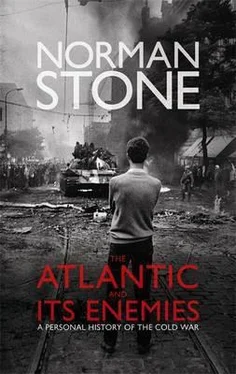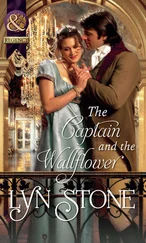It was said that the State had neglected its artists. This was in some measure quite true: it had not given great public commissions to, say, Cézanne. It had also allowed the sale of many modern paintings to foreigners. In the Third Republic, there had been a reaction against the cultural pretensions of earlier French governments, but there is no evidence at all that the civilization as a whole suffered — quite the contrary: the world beat its way to Paris. In the sixties cultural pretensions returned; but France interested the world less and less — though, to be fair, some of this was the world’s, and particularly the Anglo-Saxon world’s, fault, as knowledge of foreign languages ran down. In the fifties supposed decentralization of culture had been encouraged, at least in the theatrical world. What, in practice, this meant was that small versions of the Paris model went up everywhere, to the detriment of local character. This went together with a Communist notion that literature had been corrupted (‘bourgeois’) since the Revolution, that it needed to purify itself: such was Sartre’s attitude, in 1948, and, in 1953, Roland Barthes’s ( Le Degré zéro de la littérature ). They were contemptuous of cliché, dismissing even genuine, interesting and highly successful figures such as Édith Piaf or Charles Aznavour or Maurice Chevalier or Georges Simenon. The accent was on Brechtianism — ‘angry young men’ — as against the boulevard theatre: it was all modernism, and the hope was that the epicurean, avant garde dilettantism of the art déco world would be generalized. As Fumaroli says, this did indeed happen: within a generation, robustly bourgeois figures were going in for their version of bohemia, and popular culture more or less collapsed into out-of-date copies of Atlantic rock music. In the Third Republic, academe, not ‘culture’, had reigned: as a young education minister, Jean Zay, said in his memoirs, the greatest test was not to speak in the Senate, but before the professors gathered in the higher education council. In fact he did very well — commissioning the Palais de Chaillot, and getting Robert and Sonia Delaunay to decorate the technical pavilion of the exhibition of 1937. It was simply nonsense to write off the Third Republic as a cultural desert, but such was the tone. Later, Communist influences became very powerful, but an initial impulse came from Vichy. In 1940, with the great defeat, there were calls for a cultural purification of the country, and a General Secretariat for Youth was established, in which Catholicism and the army played their part. At Uriage a new school for administrators was set up, the beginnings of ‘technocracy’, and a Catholic thinker, Emmanuel Mounier, ‘the poor man’s Heidegger’, developed ‘personalism’. One of Vichy’s cultural ministers wrote, ‘Diriger l’art, c’est lui permettre de s’accomplir.’ A central part of this thesis was that the French universities had somehow let the national culture be frittered away in scholarly aridity, in egalitarianism. Mounier did have a reading list, but it was skimpy, and his accent lay elsewhere: he wanted to escape from the alleged academicism of literature and museums. These ideas were well-meant, in the sense that they were inspired by a feeling that ordinary people deserved a higher culture than, hitherto, they had had.
Such were the germs of the technocrats’ attitude to Culture, and after the war they were filtered through Communism, which won an enormous influence. Vichy even launched an idea of great public fetes. In this, it could rely on Rousseau, who disliked the Italian theatre and wanted demonstrations of unity; Wagner was a similar influence, and led straight to the megalomaniac producers Max Reinhardt, Gordon Craig and Erwin Piscator manipulating the whole theatre, and using light, especially, to dominate a mass. The idea of theatre as awakening — here applied for left-wing purposes — was very old, and into the 1970s it was being used in western Europe, sometimes absurdly. Could television and film take its Brechtian place?
These notions came together, in 1959, with André Malraux — one-time hero of the Left, now de Gaulle’s minister of culture. Like so many intellectuals, he was out of touch with the liberal democracy which had in effect triumphed in 1945, and, like so many, he talked of some ‘Third Way’ between capitalism and Communism, which was a false way of putting the whole problem. France thus became in 1959 the first democratic country to acquire a Ministry of Cultural Affairs, and it went on to spread far and wide, in the very propitious environment of the French State, larger than elsewhere. Malraux’s budget had been small, and his Maisons de la Culture did not flourish, but, under Pompidou, elements of grandiosity took over. This especially concerned the Centre Beaubourg, but throughout the provinces and even in Paris small replicas pullulated. There was an entirely misleading idea that this was a continuation of Louis XIV’s practices, but, now, there were far more bureaucrats than artists, and it all had to do with a very modern phenomenon, ‘leisure’. The State’s monopoly extended, notoriously, to television, with a great noise as to protectionism against supposed cultural imperialism, cheapening, etc. and in the 1980s proceeded to grandiose nonsense — ‘the clangorous fiasco of the Bastille [opera], or the absurd project of creating a National Library, by its nature a private matter, in the very centre of a gigantic Leisure Complex’ or even some enormous French version of the Las Vegas Strip, a ‘Champs-Élysées of Culture’, including Versailles.
Much of this came about with the ministry of Jack Lang, in 1981. On one level, it was popular, his team grinning away in the Kennedy- Servan-Schreiber manner. Culture, said Lang to Playboy , was to be fun. As the eighties drew to a close, Culture even gave the socialists a new lease of life, their original inspiration having failed: there was indeed fun, even though the other ministries — the economy, foreign affairs — became grim-faced as the problems began to accumulate. To begin with, the Malraux project had been very serious indeed, as befitted a country that had gone through so much, up to the Algerian war. Then 1968, an explosion of imbecile hedonism, had occurred. Theatre had begun this process and Lang himself had run a festival at Nancy that was supposed to be innovative, thought-provoking, etc. in the Brechtian manner. At least it had some sparkle, whereas the cultural commissars were taking over elsewhere (Louis Althusser’s Notes on a Materialist Theatre , or Sartre’s thoughts as to ‘a proletarian theatre’). In 1969, the Nancy Festival started a sort of annual commemoration of ‘the revolution of 1968’, the general idea being a French Wood-stock or Berkeley. Patrice Chéreau added the war of the sexes to the Brechtian war of the classes; or there was an American, in 1971, who staged a seven-hour dumb show, brilliantly illuminated, which Aragon said was the best thing he had ever seen. Lang was sacked from the Théâtre de Chaillot, in 1974, having destroyed the art déco frescos that had once seen Gérard Philipe’s triumphs, but took his revenge, claiming that France was still a cultural desert. In 1981 the ministry announced there would be ‘recognition of the cultural habits of the young, rock, jazz, photo, scientific and technical culture. Local radio… Introduction of the cultural dimension of the politics of social and professional inclusion for the young’ ( sic ). Six groupes de réflexion were set up, and no doubt various useless institutes in the education ministry where Alain Besançon’s one-time Communist friends found their places, burrowing away in the State like some sort of termite, pre-programmed and leaving nothing to record their passage but little heaps of pulverized dirt. Tocqueville had written a famous passage:
Читать дальше












![Edward Ellis - Adrift on the Pacific - A Boys [sic] Story of the Sea and its Perils](/books/753342/edward-ellis-adrift-on-the-pacific-a-boys-sic-s-thumb.webp)